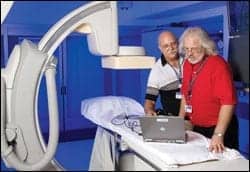Oklahoma is known for many things, from the natural beauty of its lakes and rivers to its seasonal changes, which bring beautiful colors to all the trees and surrounding foliage. Oklahoma also brings to mind college football teams like the OU Sooners and the OSU Cowboys. But it’s also known for its weather. There’s a saying here in Oklahoma: “If you don’t like the weather, just wait a little bit.” The skies can get bad in a hurry, going from just a light sprinkle to a “toad strangler,” as my granddad used to call it.
One type of bad weather that has been getting a lot of attention in the media lately is tornadoes. Moore, Oklahoma City, and Midwest City are just a few areas that have been hit by major storms. In recent years, the number and intensity of tornadoes have been increasing. According to the National Weather Service, Norman, Okla, receives an average of 55 tornadoes a year. In the past 10 years, we’ve had reports of 1,367.
Along with tornadoes come worries about lightning. Lightning isn’t a good friend to electronics. It does funny things to electrical equipment, from the usual knockout or melting solder to full-on fire. Luckily, there are many fail-safes incorporated into a lot of medical equipment, and there are surge protectors and backup generators in many, if not all, healthcare facilities.
That’s why when I came to work at W.W. Hastings Hospital in January 2013, I was surprised at what I saw: a backup to the backup power source. This was the only place I had ever seen such a setup, despite spending time in the Army and working at two other hospitals. In our OR department, I found that each scope tower as well as other pieces of equipment were fitted with their own UPS systems. Most of the towers had a Tripp Lite Smart 1200XLHG, and other equipment had either the same or equivalent power sources.
According to Tripp Lite’s literature, its UPS provides at least 10 to 15 minutes of run time on full capacity, and about 28 minutes at half load. Given that the systems were already set up on the emergency generator system, I thought to myself, “This is a little bit of overkill.”
When I asked Delo, one of the lead biomed techs here, about it, he answered in the form of a question. “Have you ever seen lightning hit a generator room? They don’t work so well afterwards.” He went on to explain, “It takes time to bring them back online after something like that. If you can buy time for a patient on the table, every little bit will help.” Well put—no further explanation needed.
But I was still curious, so I pried into it a little more. When I asked our supervisor Whitney Floyd, I got a similar answer. It takes an average of 10 seconds for an emergency generator to kick on in case of a power failure, she explained. But in our neck of the woods where storms are frequent and weather is unpredictable, do you want to take the chance it will work right?
Whitney also brought up the maintenance side: Yes, it takes a little more time to do PMs, set up a rotation, and switch batteries when needed. But all that is worth the assurance of having just a little more time that could mean so much to a patient’s life. She reminded me that it’s always better to have something and not need it than to need it and not have it.
I discovered a lot of time went into researching what was needed for a backup UPS system at our facility. It had to be hospital-grade and able to handle the load of the equipment and the type of equipment being used. The isolated ground needed to be researched, since it was on regular power until the emergency power grid switched on (that’s where facilities maintenance came in). We had to consider the amount of time the UPS system might have to be running, as well as the cost of setting it up. It was also important to take into account the actual users and how the system might affect them, as well as what type of information they needed to have.
All these factors, along with input from past biomeds like Glen Palone and Bill Jones and concern for patient safety and security, led to implementation of this backup-backup system. Each department, from OR to biomed and facilities maintenance, had a part in it. After taking time to process all this information and seeing the system work in at least one real-life situation, I, too, became a believer in the backup system.
After all is said and done, though, the fact remains the same: Having a good backup system and maintaining it are vitally important, even if you never have to use it. Despite today’s advances in technology and manufacturing, everything still has an on/off switch and runs on electricity. You always have to be prepared for power failure, because you can never put a price on life.
Eric Aimerson is a BMET II at WW Hastings Hospital in Tahlequah, Okla.
Photo credit: © Fotolotti | Dreamstime.com




